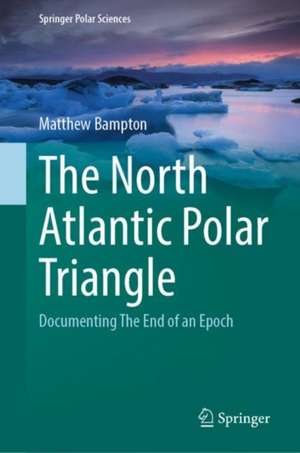The North Atlantic Polar Triangle: Documenting The End of an Epoch: Springer Polar Sciences
Autor Matthew Bamptonen Limba Engleză Hardback – 4 iul 2023
This book explores the broad trajectory of the Holocene epoch in a region defined as the North Atlantic Polar Triangle (NAPT). The text is multi-disciplinary and synthetic, and focuses on the area extending from the North Pole to the Equator, and covers 60 degrees of longitude, encompassing the entire North Atlantic and significant parts of the land-masses that surround it. It discusses the physical, ecological and cultural history of the NAPT and its bordering regions after the end of the Last Glacial Maximum. It outlines the long-term changing relationships between environmental processes and humans within this single space, providing insight into the broader and more complex interactions happening globally. The author proposes, on the basis of the changes that can be documented in the NAPT, probable trajectories of change in other equally complex but less well-documented, and less geographically constrained Earth systems. It contributes to the ongoing discussion of human transformation of the world, and the current debate about the designation of a new geological epoch, the Anthropocene. It concludes by supporting the proposition that the Anthropocene is best understood as a boundary event, marking the upper limit of the Holocene, rather than as a new epoch. The intended audience includes physical geographers, anthropologists and readers exploring the synthetic analyses of the crisis humans currently confront as the world enters a period of extraordinary change
Din seria Springer Polar Sciences
- 18%
 Preț: 735.18 lei
Preț: 735.18 lei - 18%
 Preț: 798.81 lei
Preț: 798.81 lei - 18%
 Preț: 1123.50 lei
Preț: 1123.50 lei - 18%
 Preț: 730.97 lei
Preț: 730.97 lei - 20%
 Preț: 752.16 lei
Preț: 752.16 lei - 18%
 Preț: 952.09 lei
Preț: 952.09 lei - 15%
 Preț: 643.34 lei
Preț: 643.34 lei - 15%
 Preț: 640.06 lei
Preț: 640.06 lei - 18%
 Preț: 1142.28 lei
Preț: 1142.28 lei - 20%
 Preț: 691.02 lei
Preț: 691.02 lei - 18%
 Preț: 889.29 lei
Preț: 889.29 lei - 15%
 Preț: 642.68 lei
Preț: 642.68 lei - 20%
 Preț: 694.17 lei
Preț: 694.17 lei -
 Preț: 430.59 lei
Preț: 430.59 lei - 15%
 Preț: 700.94 lei
Preț: 700.94 lei - 24%
 Preț: 1059.37 lei
Preț: 1059.37 lei - 24%
 Preț: 715.31 lei
Preț: 715.31 lei - 23%
 Preț: 635.57 lei
Preț: 635.57 lei -
 Preț: 445.29 lei
Preț: 445.29 lei -
 Preț: 357.25 lei
Preț: 357.25 lei - 18%
 Preț: 953.03 lei
Preț: 953.03 lei - 18%
 Preț: 779.57 lei
Preț: 779.57 lei - 15%
 Preț: 690.76 lei
Preț: 690.76 lei -
 Preț: 382.50 lei
Preț: 382.50 lei - 18%
 Preț: 949.55 lei
Preț: 949.55 lei -
 Preț: 352.63 lei
Preț: 352.63 lei
Preț: 943.57 lei
Preț vechi: 1150.70 lei
-18% Nou
Puncte Express: 1415
Preț estimativ în valută:
180.61€ • 196.25$ • 151.81£
180.61€ • 196.25$ • 151.81£
Carte tipărită la comandă
Livrare economică 21 aprilie-05 mai
Preluare comenzi: 021 569.72.76
Specificații
ISBN-13: 9783031272639
ISBN-10: 3031272633
Ilustrații: XV, 134 p. 22 illus., 18 illus. in color.
Dimensiuni: 155 x 235 mm
Greutate: 0.39 kg
Ediția:2023
Editura: Springer International Publishing
Colecția Springer
Seria Springer Polar Sciences
Locul publicării:Cham, Switzerland
ISBN-10: 3031272633
Ilustrații: XV, 134 p. 22 illus., 18 illus. in color.
Dimensiuni: 155 x 235 mm
Greutate: 0.39 kg
Ediția:2023
Editura: Springer International Publishing
Colecția Springer
Seria Springer Polar Sciences
Locul publicării:Cham, Switzerland
Cuprins
Chapter1. Magnitude, Frequency, and Change in Earth Systems.- Chapter2. Before the Holocene.- Chapter3. The Greenlandian.- Chapter4. The Northgrippian.- Chapter5. The Meghalayan.- Chapter6. The Anthropogenic Boundary Event.
Notă biografică
Matthew Bampton is a Professor of Geography at the University of Southern Maine. For the past decade Matthew has studied human responses to climate change in the North Atlantic during the Little Ice Age. Prior to this he worked on GIS education, field mapping techniques, human impact on Colonial New England landscapes, and mapping pre-European Indigenous settlement in coastal Maine.
Textul de pe ultima copertă
This book explores the broad trajectory of the Holocene epoch in a region defined as the North Atlantic Polar Triangle (NAPT). The text is multi-disciplinary and synthetic, and focuses on the area extending from the North Pole to the Equator, and covers 60 degrees of longitude, encompassing the entire North Atlantic and significant parts of the land-masses that surround it. It discusses the physical, ecological and cultural history of the NAPT and its bordering regions after the end of the Last Glacial Maximum. It outlines the long-term changing relationships between environmental processes and humans within this single space, providing insight into the broader and more complex interactions happening globally. The author proposes, on the basis of the changes that can be documented in the NAPT, probable trajectories of change in other equally complex but less well-documented, and less geographically constrained Earth systems. It contributes tothe ongoing discussion of human transformation of the world, and the current debate about the designation of a new geological epoch, the Anthropocene. It concludes by supporting the proposition that the Anthropocene is best understood as a boundary event, marking the upper limit of the Holocene, rather than as a new epoch. The intended audience includes physical geographers, anthropologists and readers exploring the synthetic analyses of the crisis humans currently confront as the world enters a period of extraordinary change
Caracteristici
Defines the NAPT in a way not previously identified as a unit of geographical analysis Analyzes the current state of knowledge about changes within the NAPT Proposes trajectories of change in other complex but less well-documented earth systems
